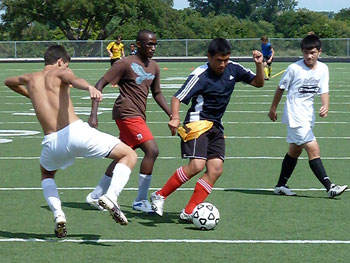Game reductions for all teams may affect some schools more than others.

The Minnesota State High School soccer season got underway across the state on Monday. Teams started their first week of training with only a few short days before many will play friendlies to prepare themselves for their seasons, which start in only a few weeks. As always, the season in Minnesota is condensed with most sectionals being played in mid-October, just 6 weeks from when most teams start their conference schedule in early September.
There are a few changes this season as a few teams were moved to new conferences. Notably, Armstrong who used to be in the Classic Lake Conference, was voted out due to declining enrollment. They have now moved to the Northwest Suburban Conference and will face off against teams like Coon Rapids, Blaine, Osseo and Maple Grove.
Another switch sees Eden Prairie move to the Lake Conference and will now play Edina, Hopkins, Minnetonka and Wayzata.
But the biggest change for all schools participating in soccer in the Minnesota State High School League (MSHSL) this year is a reduction in the amount of games a team can play. In past years coaches could schedule up to 18 games. This year the MSHSL has amended that to 16 games. While some might argue that 18 games was too many and a reduction allows teams to play a more reasonable schedule with a few more training sessions, others feel it could hurt their chances of being seeded higher in sections because of the perceived soft conference they may participate in.
According to Jason Jacob, head coach of Coon Rapids Boys Varsity Team, he has dropped non-conference games against St. Michael and Prairie Seeds Academy this year to comply with the 16 maximum. He explained that each conference is different in how many conference games they play depending on how many teams are participating. In his conference there are 11, so he has 10 conference games, which now allows him only 6 non-conference games. He says it makes a difference and he needs to choose those matches carefully.
“It doesn’t really affect us so much because we would use those extra two games to play some smaller schools which then gave us a chance to work on some things,” said Jacob. “But you want to keep the games against the better schools. For us that’s Cretin Derham-Hall, White Bear Lake and Eastview. We look at those as staple games where we need to challenge ourselves beside a few sectional teams we might play.”
Jacob says there’s no doubt in his mind that the reduction in games was a cost saving measure by the MSHSL. While he believes it doesn’t affect his team much, he does think it has a much greater effect on good teams that play in weak conferences and need those games to challenge themselves.
The Coon Rapids coach is a section representative so he was privy to some information about the decision. He says the MSHSL was looking to average about 2 games a week in an 8-week season. He believes most coaches would have preferred if they were left to make the decision to play 16 or 18 games.
“Our biggest gripe as coaches was there were years when we wanted to play 4 or 5 early games in those first couple of weeks to figure out the players on our squad. Other years we knew our team better and we would choose to play just 16. I think the feeling as coaches was, don’t take those games away from us. Let us make those decision.”

Jorey Erickson is a coach of one of those perennially strong teams that Jacob referred to that play in softer conferences. He is the head coach of St. Paul Central High School Boys Varsity squad who play in the St. Paul City Conference. As Erickson understands it, all sports that were not self-sustaining had a maximum game reduction given to them this season. For his team, he was already restricted to 16 games, a cost reduction measure the St. Paul Conference had imposed several years ago. However, teams were allowed to play 18 games if those matches were funded outside the school system which Erickson did by having the soccer booster club raise funds to pay for them.
“I think the Minneapolis City Conference as well as the St. Paul Conference is a good example,” said Erickson. “Generally our conference has gotten better. But if you look at the whole state and how they view our conference they don’t really value it very highly. So you need to go outside the conference to play more notable teams which you hope will give you better rankings and therefore help you in your section rankings. For us, we’ve just always wanted to challenge ourselves against the top teams that are typical of what we will see in the playoffs.”
Erickson says that in their conference there are often inconsistencies, not only amongst teams but within teams. He says they may see a strong team in their first match-up and weaker players the second time around, a phenomena he believes happens more in the inner-city because many players have to work beside going to school and playing soccer. He states there are also issues with family systems that may have different values when it comes to sports and some players also have issues with transportation to and from school for extracurricular activities, like soccer. “You could face a team of all-stars the first game and the next game it will be a whole new group of players on the field,” said Erickson.
The Central High School coach, who by his request has moved back up to Class AA this season, states that with a 10-game schedule he now only has six games to play against teams “you might know about.” “We miss out on two more games that could have made us better and could have impressed others to get a better ranking in the sectionals,” said Erickson.
Erickson states that losing the two non-conference games is a mixed bag. He explains that it is a grind during the season with so many games and believes the extra training sessions and a little more rest could help his starters. Then again he believes that playing so many games against so many different opponents is part of the attraction for players to participate in high school soccer.

 Clap
Clap